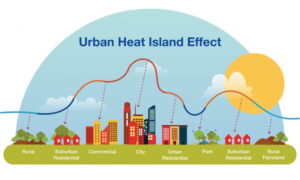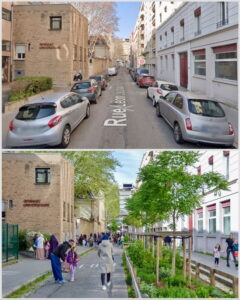By Pasqualino Tomassi, Co-Chair, IUCN Urban Alliance, Switzerland

As urbanisation accelerates and climate change intensifies, cities face increasingly frequent and severe heatwaves. This challenge demands innovative solutions, but evaluating the effectiveness of new initiatives is crucial for ensuring their impact.
Cities experience the urban heat island (UHI) effect, with temperatures significantly higher than surrounding areas (Figure 1). This is largely due to dense construction, dark surfaces, and lack of vegetation. The consequences are serious, impacting public health, increasing energy consumption, and even causing premature mortality (Figure 2). Short-term temperature peaks are particularly concerning, as they can be much more intense than seasonal averages and pose a greater immediate risk to human health.
Studies on European cities have identified key strategies for combating extreme heat (Figure 3):

Exploiting existing data: Utilise available monitoring systems and modeling techniques, like satellite remote sensing, to inform decision-making processes.
Implementing behavioral change: Public awareness campaigns, early warning systems, and targeted protection for vulnerable groups.
Establishing heat action plans and appointing heat officers to coordinate responses.
Adopting multi-scale and cross-sectoral approaches: address heat extremes by considering different spatial scales, from individual buildings to entire cities, and fostering collaboration between government levels and urban departments.
Among these strategies, one of the most promising solutions for mitigating the UHI effect is enhancing urban green infrastructure (Figure 4). Research across 93 European cities indicates that increasing tree cover to 30% could reduce heat-related deaths by nearly 40%. However, the effectiveness of green spaces in

cooling urban areas relies on various factors such as their size, shape, composition, and spatial configuration. Integrating more green areas into urban planning not only helps in reducing temperatures but also contributes to improving air quality and supporting biodiversity.
Implementing effective solutions requires understanding the challenges and opportunities unique to each city. There is a need for measurable indicators and evaluation tools to track progress and assess the impact of adaptation and mitigation efforts. The Sustainable Development Goals (SDGs) framework offers a structured set of universally recognised metrics to guide cities and countries in implementing, evaluating, and improving their adaptation and mitigation responses.
Complementing this, the IUCN Global Standard for Nature-based Solutions (NbS) provides a more specific framework tailored to the design and evaluation of interventions that utilise the benefits of natural systems. This standard, with its eight interconnected criteria and 28 indicators, ensures that NbS interventions are not only effective in addressing immediate challenges, such as extreme heat, but are also sustainable and adaptable in the long term (Figure 5). By aligning NbS strategies with the broader SDGs framework, cities can create interventions that are both impactful and resilient, addressing environmental, social, and economic dimensions of urban heat mitigation.
In conclusion, combating extreme heat in cities necessitates a multi-faceted approach incorporating diverse solutions tailored to each urban environment. Developing and implementing comprehensive evaluation systems is crucial. By integrating the SDGs framework with tools like the IUCN Global Standard for NbS, and considering factors beyond temperature reduction, such as social equity and biodiversity, we can create truly sustainable and resilient cities. The urgency of addressing urban heat requires not only innovative strategies but also robust methods to assess their effectiveness, ensuring that our efforts lead to meaningful improvements in urban environments and quality of life.
 |
 |
| Figure 4. A comparative before-and-after image of a road in Lyon with and without increased tree cover. | Figure 5. The eight Criteria that make up the IUCN Global Standard for NbS are all interconnected. © IUCN, International Union for Conservation of Nature and Natural Resources. |
Disclaimer: The views expressed in this piece are those of the author/s and do not necessarily reflect the views or policies of AIDMI.